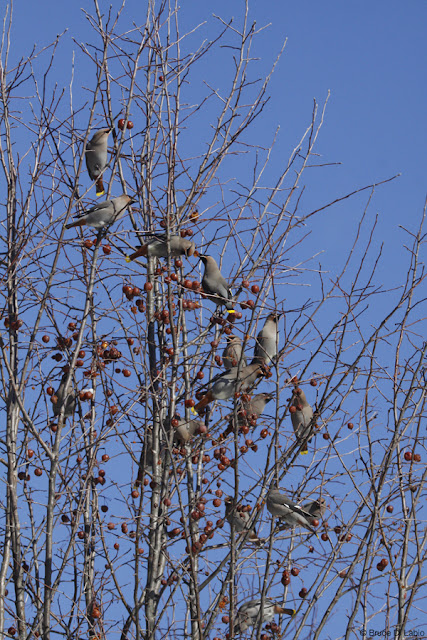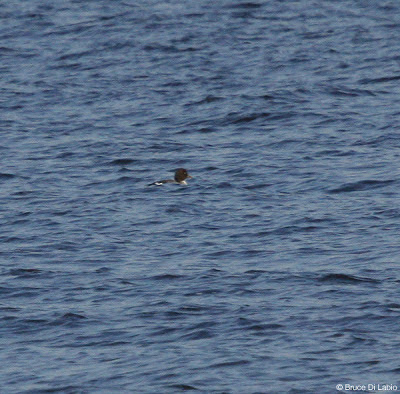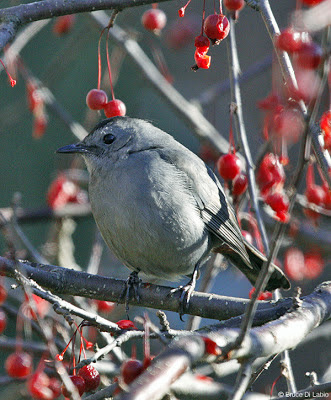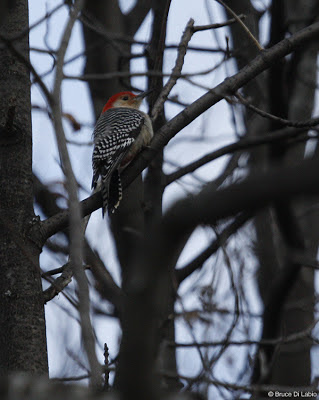Hi Everyone
Spent a number of hours birding along the Ottawa River and a couple of nearby woodlots. Overall it was quiet except for numerous flocks of Bohemian Waxwings flying over. I observed one flock of 100+ near the corner of Moodie Drive and Carling Ave. and another flock of 50+ near Carleton University. With the number of fruit/berry trees in the Ottawa area I'm sure the waxwings will be around for some time.
Still 1000's of Canada Geese along the Ottawa River and feeding in fields on the outskirts of the city. I've noticed on birding list servers there has been a few Pink-footed Geese in north-eastern United States and Newfoundland. I know it's tedious but it's worth checking all the flocks of geese. There is a spring record of Pink-footed Goose at Plaisance, Quebec back in late April 2004. This maybe the next new species for Ontario. With the Pink-footed Goose record from Plaisance and a Barnacle Goose record (banded) further east at Bainsville near the Ontario-Quebec border be sure to check all Canada Geese flocks. Anything is possible!
Good birding, Bruce
Wednesday, November 28, 2012
Tuesday, November 27, 2012
November 26, 2012 First snow fall of the season.
 |
Which one should I eat? |
 |
No fruit is left on touched. |
 |
These nomadic wanderers can travel in large flocks in search of food. |
 |
No problem! |
 |
Most of their winter diet is made up of berries and fruit. |
 |
An American Robin also consumes many berries and other fruits during the winter months. |
 |
Many species of birds will use snow for a source of water during the winter. |
 |
This American Robin with a leg injury picks up fallen fruit on the snow covered ground. |
 |
Even though this adult Ring-billed Gull is missing a foot it has fared well and will survive. |
November 23, 2012 Another Cave Swallow near Ottawa,Ontario
The Ottawa-Gatineau district's second record of Cave Swallow was discovered this afternoon at Constance Bay by Jeff Skevington. The swallow was feeding along the edge of the Ottawa River off the end of Whistler Road. It was present til' dusk and on November 24th at dawn it was observed for a brief time before disappearing. I was able to take a number of photos to document this record of the southwestern subspecies P.f. pallida. The first record also P.f. pallida was found on November 3rd feeding over the Ottawa River at Bate Island along with a Cliff Swallow. The Cliff was observed on November 4 and 5 but no Cave Swallow. On November 6 both swallows were reported again at the same location late afternoon and never seen again. Below is a couple of photos of the 2nd record of a Cave Swallow for the Ottawa-Gatineau district.
Good birding, Bruce
Good birding, Bruce
 |
Cave Swallow: P.f. pallida November 23, 2012 Constance Bay,Ontario |
 |
Cave Swallow: P.f. pallida November 23, 2012 Constance Bay,Ontario |
November 20-21, 2012 Birds in search of berries and fruit.
 |
The American Robin can survive our winters as long as there is enough food which includes Mountain Ash, Buckthorn, Wild Grapes, Crab Apples and other fruit-berry producing trees/plants. |
 |
A female Pine Grosbeak picks up pieces of fallen crab apples. |
 |
Even a Pileated Woodpecker was eating crab apples. |
 |
The Pileated Woodpecker checks over a telephone pole for insects. |
 |
A large group of Bohemian Waxwings resting. |
 |
American Robin |
 |
A male Northern Cardinal enjoying a morning snack. |
Sunday, November 25, 2012
November 19, 2012 Female Barrow's Goldeneye Identification
Hi Ontbirders,
With the influx of goldeneyes during the past few weeks into southern Ontario, I've been looking through the flocks for both male and female Barrow's Goldeneyes. Today, November 19, I observed a female Common Goldeneye with an orange-yellow bill on the Ottawa River at Shirley's Bay. This is the second individual that I've seen during the past two weeks and I've had a few local birders report possible female Barrow's that have turned out to be Common Goldeneyes. The bill colour of female Barrow's is only an "aid" to the identification and it is not diagnostic. Most important is to look at the head shape. The head of the female Barrow's Goldeneye has an oval shape created by a steep forehead, flat crown and elongated hind neck feathers like a mane. The latter gives the appearance of a swept back crest, similar to the male Barrow's and female Hooded Merganser. The head shape of the Common Goldeneye lacks the "puffiness" of the female Barrow's. Common has a rounded rather than flat crown with a sloping forehead and longer bill. Some birds appear intermediate.
Good birding, Bruce Di Labio and Ron Pittaway
See link: Bill Colour and Identification of Female Barrow's Goldeneye by
Bruce Di Labio, Ron Pittaway and Peter Burke in Ontario Birds 15 (2): 81-85,
1997.
http://www.jeaniron.ca/2010/FemaleGoldeneyes.pdf
See also photos on my blog.
http://brucedilabio.blogspot.ca/2009/11/november-12-20-2009-barrows-goldeneyes.html
Di Labio Birding Website
Courses and Field Trips
http://www.dilabiobirding.ca
http://www.brucedilabio.blogspot.com
Bruce Di Labio
400 Donald B. Munro Drive
P.O. Box 538
Carp, Ontario
K0A 1L0
Office 613-839-4395 Cell 613-715-2571
With the influx of goldeneyes during the past few weeks into southern Ontario, I've been looking through the flocks for both male and female Barrow's Goldeneyes. Today, November 19, I observed a female Common Goldeneye with an orange-yellow bill on the Ottawa River at Shirley's Bay. This is the second individual that I've seen during the past two weeks and I've had a few local birders report possible female Barrow's that have turned out to be Common Goldeneyes. The bill colour of female Barrow's is only an "aid" to the identification and it is not diagnostic. Most important is to look at the head shape. The head of the female Barrow's Goldeneye has an oval shape created by a steep forehead, flat crown and elongated hind neck feathers like a mane. The latter gives the appearance of a swept back crest, similar to the male Barrow's and female Hooded Merganser. The head shape of the Common Goldeneye lacks the "puffiness" of the female Barrow's. Common has a rounded rather than flat crown with a sloping forehead and longer bill. Some birds appear intermediate.
Good birding, Bruce Di Labio and Ron Pittaway
See link: Bill Colour and Identification of Female Barrow's Goldeneye by
Bruce Di Labio, Ron Pittaway and Peter Burke in Ontario Birds 15 (2): 81-85,
1997.
http://www.jeaniron.ca/2010/FemaleGoldeneyes.pdf
See also photos on my blog.
http://brucedilabio.blogspot.ca/2009/11/november-12-20-2009-barrows-goldeneyes.html
 |
A distant female Commmon Goldeneye with a orange/yellow bill at Shirley's Bay. |
Di Labio Birding Website
Courses and Field Trips
http://www.dilabiobirding.ca
http://www.brucedilabio.blogspot.com
Bruce Di Labio
400 Donald B. Munro Drive
P.O. Box 538
Carp, Ontario
K0A 1L0
Office 613-839-4395 Cell 613-715-2571
November 17-18, 2012 Birding Prince Edward Point and Presqui'le
 |
This immature Northern Shrike was investigating all the small bird activty around a feeder. |
 |
Barred Owls appear to be again on the move south this fall. Numerous birds have been reported along the east shore of Lake Ontario and Amherst Island. |
 |
An adult winter plumage Bonaparte's Gull feeding off Owen Point at Presqu'ile. |
 |
Incredibly low water levels along the Lake Ontario. You can walk from Owen Point to Gull Island without getting your feet wet! |
 |
A Snowy Owl walks out into the water for a bath and a drink. Surprisingly this is only one of the few times I've ever witnessed an owl bathing. |
 |
After its bath the owl flapped its wings a number of times and began preening. |
November 12-17, 2012 A late lingering Gray Catbird in Carp.
 |
A late lingering Gray Catbird was a surprise as it fed on crab apples. |
 |
Gray Catbird |
 |
Gray Catbird |
 |
A flock of Bohemian Waxwings finished off the fruit on this tree. |
 |
A male Pine Grosbeak feeds on crab apples. |
 |
The Gray Catbird sometimes appeared briefly before dusk likely spending the night in a nearby dense cedar tree. |
Saturday, November 24, 2012
November 10-11, 2012 Amherst Island Birdng
Hi Everyone
Spent the weekend birding Amherst Island. With great weather and very mild temperatures, it felt more like mid October and a few species of reptiles and amphibians were still active along with a couple of butterfly species. The Owl Woods produced 4 species of owls with Northern Saw-whet, Long-eared, Short-eared, and Barred Owl being found. A check along the roads produced a number of American Kestrel, Rough-legged Hawk, Red-tailed Hawk, and Northern Harrier. The KFN property at the east end of the island was quiet with little activity.
Good birding, Bruce
Directions: Amherst Island: Located 18 km. west of Kingston. Exit off Hwy. 401
at exit 593 (County Rd. 4, Camden East) and drive south to the very end
(Millhaven). Turn right on Hwy. 33 and drive 100 metres until you see the sign
for the Amherst Island ferry. The ferry (20 minute trip) leaves the mainland on
the half hour and leaves the island on the hour. Cost is $8.00 Canadian round
trip. There are no gas stations on the island. There are restrooms on the ferry,
and at the island ferry dock. The East End K.F.N. property is at the
easternmost part of the island on the east side of the Lower Forty Foot Road.
Because of liability issues, visitors to the Kingston Field Naturalists' property at the east end of Amherst Island MUST be accompanied by a KFN
member. For KFN contact information or how to become a member, please visithttp://kingstonfieldnaturalists.org/ ."
Because of liability issues, visitors to the Kingston Field Naturalists' property at the east end of Amherst Island MUST be accompanied by a KFN
member. For KFN contact information or how to become a member, please visithttp://kingstonfieldnaturalists.org/ ."
 |
Numerous Common Loons were observed on the crossing. |
 |
A 2nd year (cycle) Iceland Gull was observed along the south shore of the island. |
 |
A Mink in full stride. |
 |
With mild conditions everyone was out sunning! |
 |
A Northern Water Snake was also out with the warm temperatures. |
 |
American Tree Sparrows were easy to observe at the feeders in the Owl Woods. |
 |
A number of American Kestrel were observed feeding along the roads catching insects that were active due to the warm temperatures. |
 |
A Barred Owl eating a Garter snake a first for me! |
 |
A male Red-bellied Woodpecker was vocal in the woods giving a "chuck" call. |
 |
A late Fox Sparrow was feeding at the feeders in the Owl Woods. |
November 6, 2012 birding Amherst Island
Hi Everyone
Spent the day birding Amherst Island. Overall it was quiet but there were a few owls in the Owl Woods including 2 Northern Saw-whet, 2 Long-eared and 1 Barred Owl. Also species present included a small flock of White-winged Crossbill, a couple of Common Redpoll, 1 Fox Sparrow and a Red-bellied Woodpecker at the feeders. A walk out to the east point, KFN property produced a late Dunlin, 34 Tundra Swan, and 500+ Greater Scaup. There were a small number hawks including American Kestrel, Northern Harrier, Red-tailed Hawk and Rough-legged Hawk.
Good birding, Bruce
Directions: Amherst Island: Located 18 km. west of Kingston. Exit off Hwy. 401
at exit 593 (County Rd. 4, Camden East) and drive south to the very end
(Millhaven). Turn right on Hwy. 33 and drive 100 metres until you see the sign
for the Amherst Island ferry. The ferry (20 minute trip) leaves the mainland on
the half hour and leaves the island on the hour. Cost is $9.00 Canadian round
trip. There are no gas stations on the island. There are restrooms on the ferry,
and at the island ferry dock. The East End K.F.N. property is at the
easternmost part of the island on the east side of the Lower Forty Foot Road.
Because of liability issues, visitors to the Kingston Field Naturalists' property at the east end of Amherst Island MUST be accompanied by a KFN member. For KFN contact information or how to become a member, please visithttp://kingstonfieldnaturalists.org/ ."  |
The Owl Woods on Amherst Island will be closed from November 19-December 9th. |
 |
One of two Northern Saw-whet Owls that were present in the Owl Woods. |
 |
A section of the Owl Woods is now fenced off and there is no access. |
 |
The Long-eared Owl is a regular migrant on the island and usually very wary. This individual was very tame. |
 |
This Long-eared Owl spent most of the day roosting quietly in a Jack Pine. |
 |
A small group of Evening Grosbeaks was a nice bonus on the island. |
 |
These birds were feeding on the Staghorn Sumac fruit. |
 |
The Red-bellied Woodpecker continues to expand its range north into eastern Ontario. |
 |
The low water levels on Lake Ontario continue and the gravel point at the east end of Amherst island is now connected to the first island. |
 |
Access to the east point KFN property is restricted. You must be accompanied by a KFN member. |
 |
A late lingering Dunlin on the KFN property. |
 |
The Snow Bunting is an Arctic breeder and winters in eastern Ontario. |
 |
Usually travelling in flocks this individual was on its own. |
Subscribe to:
Posts (Atom)


